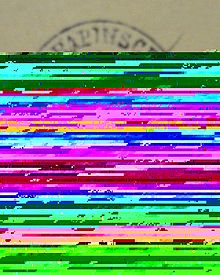Data recovery
Data recovery ( English data restore , data recovery ) means the restoration of original data after a data loss on a data carrier in the narrower sense as well as the detection of incorrectly transmitted data units and their recovery in the broader sense.
Causes of data loss
The data carriers in information and communication technology have a relatively short lifespan of a few years to a few decades, depending on the medium, physically or chemically. By external influences (mechanical damage, strong electromagnetic fields, sunlight at optical disk, hazards , etc.) can be modified on storage media or unusable data. The cause can also be found in incorrect behavior by data users by inadvertently making changes to data, e.g. B. by accidentally overwriting a file. The installation of a new program or operating system version can also lead to data inconsistency if the new version is not backwards compatible with regard to the programs used or the data to be processed .
Data backup measures
For this reason, precautions are taken preventively and promptly for important data in the event of data loss, incorrect manipulation or modification of data, in order to enable data to be restored with the help of backup copies made prior to the damage and with the most current status possible. A further complicating factor is that errors can also arise when creating the backup copy, which must be discovered and eliminated as quickly as possible by comparing them with the original data. Corresponding security measures must be taken on different levels ( byte , field, data record , file , transaction level, database , application level, on a system-wide level or even in a network of computers) with appropriate procedures.
Depending on the security measures taken, the data recovery procedures also differ.
In the event of a catastrophe , such as natural hazards, in which both the original data and its backup copy and transaction logs have been partially destroyed and no precautionary security measures have been taken, there is at best the possibility of data recovery as an emergency measure, with only one attempt being made partially damaged or changed storage medium to restore the most important, relevant data fragments as well as possible.
Basics
A restoration may be necessary after individual, human errors (accidental deletion), but also after a defect in storage media (due to external, extreme environmental influences, mechanical fatigue, etc.), if other system errors occur or after the activation of malware (English: " malware "). Sometimes a recovery is only possible with the help of further technical measures, but data can also be irretrievably lost.
Self-monitoring systems such as SMART , which is supported by all modern hard drives, can prevent the threat of data loss by detecting signs of wear and tear early on. Using an antivirus program reduces the risk of data loss through malware. Deleted data can be restored using a recycle bin or a system restore in many operating systems. Various software solutions on the market, such as IsoBuster or Ontrack EasyRecovery , also promise the retrieval of data believed to be lost, which can no longer be restored using the internal functions of the operating system. However, this only works under certain circumstances and is directed e.g. B. how often a data segment has been overwritten. The last point of contact for injured parties can be to consult a specialized company. In particularly severe cases, data is reconstructed from storage media even under clean room conditions.
The technical basis for many recovery measures is the fact that files are not physically deleted on most file systems when they are deleted or formatted , but are initially only "hidden" or marked as "deleted". However, the data itself remains on the hard disk until the corresponding area is overwritten with new data. The situation is different after a physical deletion of files with the help of special programs ( erasers ) or program functions of the system administration (overwrite mass storage with zeros). These optionally overwrite the file contents several times with fixed patterns or random contents before deleting them, making it impossible to restore the previous data.
Data recovery companies
Recovering lost data is often associated with high costs. Some companies take advantage of the plight of their customers and deceive users in data recovery. The reasons for this include a lack of quality assurance measures such as a seal of approval in the area.
In general, it is advisable to take a look at the website of the manufacturer of the respective data carrier. They either offer appropriate services themselves or list suitable companies.
See also
- TestDisk : command line program for data recovery; free software
- PhotoRec (overy): free data recovery software
- Parted Magic , SystemRescueCd , grml : free data recovery with Linux
- Hiren's BootCD : Rescue or restore broken Microsoft Windows systems
- Recuva , software to recover deleted data
Web links
- Link catalog on the subject of data recovery at curlie.org (formerly DMOZ )
literature
- Christian Bartsch: Data recovery: a matter of trust: causes, prevention, strategy, reaction, ISBN 9783947256006
Individual evidence
- ↑ Top 10: Causes of Data Loss. Retrieved September 25, 2019 .
- ↑ Recover deleted files - this is how you save your data. Retrieved September 25, 2019 .
- ↑ Free data recovery: programs to recover deleted files. Retrieved September 25, 2019 (German).
- ↑ Thorsten Eggeling, Michael Rupp & Hermann Apfelböck: Data recovery - restore deleted files . In: PC WORLD . ( pcwelt.de [accessed September 25, 2019]).
- ↑ Self-experiment data recovery: Which company is ripping me off? | STRG_F. Retrieved September 25, 2019 .
